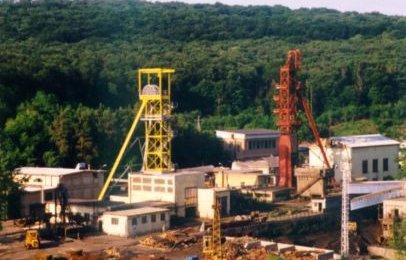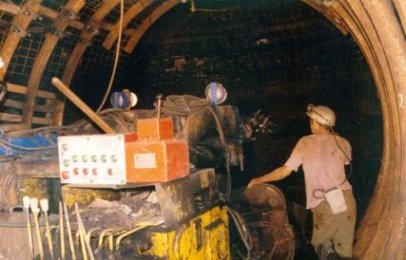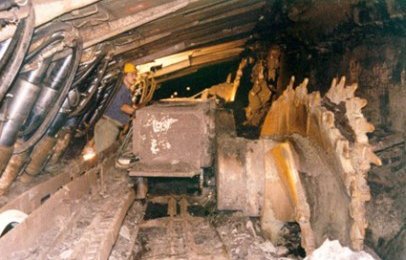In 2006 the mining plant was officially discontinued in Lyukóbánya, which is just 10 km’s away to the North from the third largest city of Hungary, Miskolc. The basin of Borsod holds more than two centuries of coal mining history. Within this period Lyukóbánya can look back on 68 years.
The development and existence of the mine was always driven by the fuel needs of the industrial environment of the area.
This is the case today and this is why Lyukóbánya - despite its significant undeveloped mineral wealth - inevitably had to be closed.
For all those who are interested in the recent history of this beautiful branch of industry, the mining, we summarize the typical data of Lyukóbánya below.
All over the area of the mine five coal seam mining site evolved, two of which were placed under cultivation. From 1950 until the date of the closure the IV. (Adriány synth [level???]) coal-bed was cultivated; which was extending in nearly 300m depth. This brown coal-bed is 2.0-2.8 m thick. Its average calorific value is 11,600 kJ/kg. The coal produced was almost all used to fuel the Borsod Power Plant for several decades.
The mine had four vertical shafts, two of which were centrally installed. These served the purpose of personnel and material distribution, ventilation and delivering of the produced materials.
The pit gas of the mine was not dangerous and flammable. It was not qualified for coal dust and gas outburst risks nor for dust and radiation injury.
At the beginnings the typical cultivation technology of Lyukóbánya was the bomb cut metal beam fuse longwall. The transportation was solved by low-capacity trams.
In the 1960s and 1970s there were significant upgrades. The coal has been mined with complex mechanized home-advancing longwall technology that turned out to be a great success ever since. The pieces of fronthead mining equipment used were hydraulic shields cutter/ loader and chain conveyor. The last longwall mine before the closure was 135 m wide forehead with decreasing run-out length.
The cutter caught a depth of about 0.6 m cut of coal along the carbon front wheel. The appropriate cutting progress was achieved by the continuous stepping of the hydraulic shield units in order to safeguard the top and bottom rock layers. The cutter was equipped with two wheels of 1.6 m diameter containing paddle blades. The technology that was introduced more than 30 years ago was in use until the mine was closed. The shield units were Polish while the cutters were made in Germany.
The coal extracted from the surface was broken on the drift. Coal was delivered to the pit from the surface with a rubber conveyor device having a maximum capacity of 400 tons per hour.
Creating a close unity of the preparation and the working systems was also a priority in Lyukóbánya, as in all underground mines. The recesses were cut using road driving machines equipped with embedded track. However, prior to the closure years the tunneling was stopped.
The recesses were safeguarded with TH rings having closed circular sections 4 m in diameter. The length of the open drift sections that were formed in the day-drifts of Lyukóbánya reached the length of 50 kilometers. It's close to the entire length of the metro lines of Budapest. Prior to the closure the length of the drift did not even reach 30 km.
Since 1977 the annual production from the mine was close to 1 million tons of coal. In contrast, the annual production at the time of the closing in 2004 was about 250 thousand tons.
The controlling of the technology processes of mining happened by means of the dispatcher center. The coal was transported to the surface with a bucket capable of carrying 7 tons. In addition to the Skyp delivery system previously the pneumatic transmission of coal played an important role, but the latter did not operate in the years preceding the mine closure either.
The coal was classified on the surface. The large barren pieces were selected manually and transported to dumps. Coal was previously transferred by means of a ropes course established between Lyukóbánya and Berente 14 km in length to the coal separator, and the power plant finally. Throughout the last years it was transported by lorry directly to the power plant. Smaller proportion of the mined coal was sold directly to the people.
From the 5th of January, 2004 the Lyukószén Mining Investment Ltd. was the operator and then, from 1st of June the owner of Lyukóbánya. Until the end of September it had the opportunity of producing coal and had to perform the tasks of the permanent closure later.
Although the sector has significant unexplored resources the coal is not marketable due to its high sulphur content under the current environmental legislation. Thus, the closure was inevitable.
So the mine was closed but the industrial area with its long history along with valuable real estates, tools, and materials that may be sold in the mining and outside of it were left behind.
Further activity of Lyukószén Mining Investment Ltd. is aimed at utilizing the available assets. Since the closure of the mine domestic and foreign mining companies creamed off and bought the utilizable parts of mining assets. The company managed to sell a major part of other materials and tools.
Some other devices such as the F-8 drift cavity driver waits for utilization in the expediences of Lyukószén Ltd. as well as groundwater cavity trainings.
The higher-valued part of the properties form the basis of a multi annual investment period targeted at social benefits. Hermetically separated lies another part of the area to provide buildings and tools to carry out smaller-scale industrial activities.
Operating on its own, there is a well-equipped woodworking shop located at the factory space.
The various forms of exploitation of the resources has already reached the design and realization stage.
An interesting part of the joint property is Újakna that can be found in Miskolc-Pereces; it functioned as an air-shaft and is now under the protection of cultural heritage. The county government of Borsod-Abaúj-Zemplén County has logged its demand on it earlier to form a mining monument.




